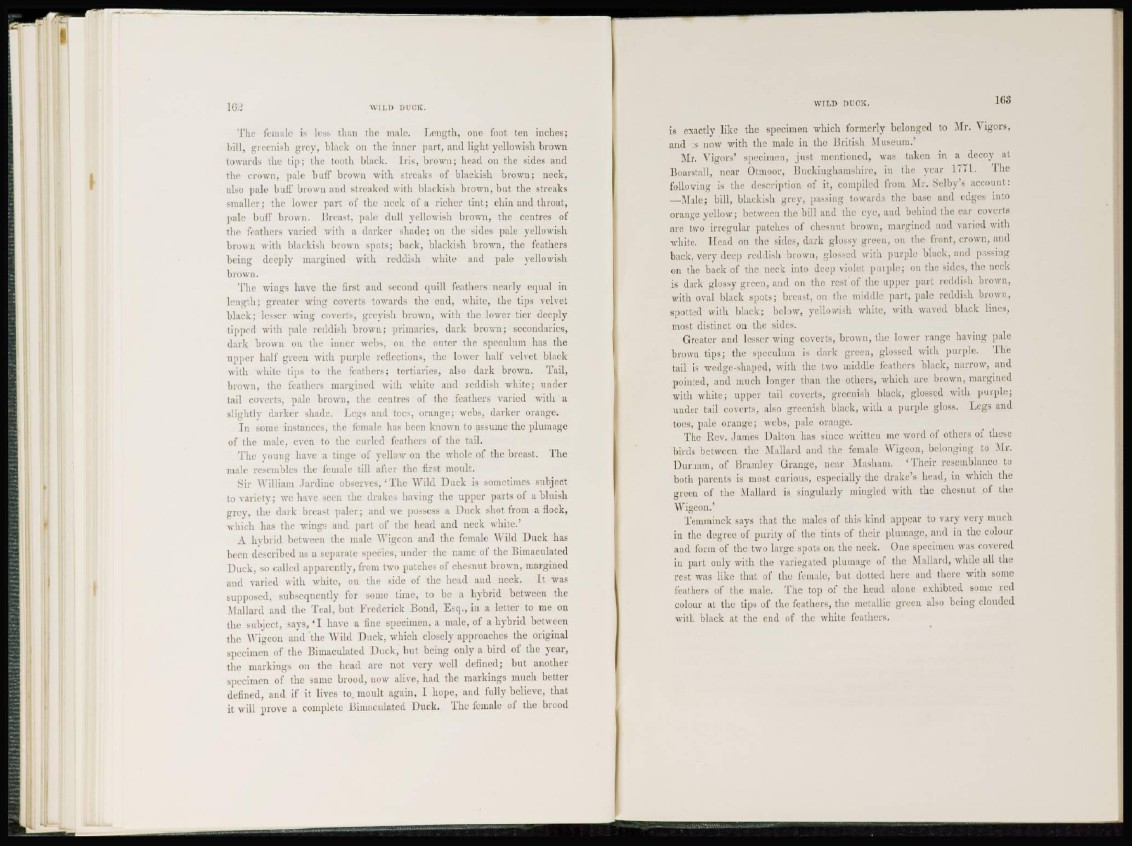
The female is less than the male, Length, one foot ten inches;
bill, greenish grey, black on the inner part, and light yellowish brown
towards the tip; the tootli black. Iris, brown; head on the sides and
the crown, pale buff brown with streaks of blackish brown; neck,
also pale bull* brown and streaked with blackish brown, but the streaks
smaller; the lower part of the neck of a richer tint; chin and throat,
pale buff brown. Breast, pale dull yellowish brown, the centres of
the feathers varied with a darker shade; on the sides pale yellowish
brown with blackish brown spots; back, blackish brown, the feathers
being deeply margined with reddish white and pale yellowish
brown.
The wings have the first and second (pull feathers nearly equal in
length; greater wing coverts towards the end, white, the tips velvet
black; lesser wing coverts, greyish brown, with the lower tier deeply
tipped with pale reddish brown; primaries, dark brown; secondaries,
dark brown on the inner webs, on the outer the speculum has the
upper half green with purple reflections, the lower half velvet black
with white tips to the feathers; tertiaries, also dark brown. Tail,
brown, the feathers margined with white and reddish white; under
tail coverts, pale brown, the centres of the feathers varied with a
slightly darker shade. Legs and toes, orange; webs, darker orange.
I n some instances, the female has been known to assume the plumage
of the male, even to the curled feathers of the tail.
The young have a tinge of yellow on the whole of the breast. The
male resembles the female till after the first moult.
Sir William Jardinc observes, ( T h e Wild Duck is sometimes subject
to variety; we have seen the drakes having the upper parts of a bluish
grey, the dark breast paler; and we possess a Duck shot from a flock,
which has the wings and part of the head and neck white*
A hvbrid between the male Wigcon and the female Wild Duck has
been described as a separate species, under the name of the Bimaculated
Duck, so called apparently, from two patches of chesnut brown, margined
aud varied with white, on the side of the head and neck. It was
supposed, subsequently for some time, to be a hybrid between the
Mallard and the Teal, but Frederick Bond, Esq., in a letter to me on
the subject, savs, ' I have a fine specimen, a male, of a hybrid between
the AVigeon and the Wild Duck, winch closely approaches the original
specimen of the Bimaculated Duck, but being only a bird of the year,
the markings on the head are not very well defined; but another
specimen of the same brood, now alive, had the markings much better
defined, and if it lives to. moult again, I hope, and fully believe, that
it will prove a complete Bimaculated Duck. The female of the brood
is exactly like the sjmcimen which formerly belonged to Air. Vigors,
and is now with the male in the British Museum.'
Mr. Vigors' sped mini, just mentioned, was taken in a decoy at
Boars tall, near Otmoor, Buckinghamshire, in the year 1771. The
following is the description of it, compiled from Mr. Selby's account:
—Male; bill, blackish grey, passing towards the base and edges into
orange yellow; between the bill and the eye, and behind the ear coverts
are two irregular patches of chesnut brown, margined and varied with
white. Head on the sides, dark glossy green, on the front, crown, and
back, very deep reddish brown, glossed with purple black, and passing
on the back of the neck into deep violet purple; on the sides, the neck
is dark glossy green, aud on the rest of the upper part reddish brown,
with oval black spots; breast, on the middle part, pale reddish brown,
spotted with black; below, yellowish white, with waved black Hues,
most distinct on the sides.
Greater and lesser wing coverts, brown, the lower range having pale
brown tips; the speculum is dark green, glossed with purple. The
tad is wedge-shaped, with the two middle feathers black, narrow, and
pointed, and much longer than the others, which arc brown, margined
with white; upper tail coverts, greenish black, glossed with purple;
under tad coverts, also greenish black, with a purple gloss. Tegs and
toes, pale orange; webs, pale orange.
The Rev. James Dalton has since written me word of others of these
birds between the Mallard aud the female Wigcon, belonging to Mr,
Durham, of Mramley Grange, near Masham. 'Their resemblance to
both parents is most curious, especially the drake's head, in which the
green of the Mallard is singularly mingled with the chesnut of the
Wigcon.'
Temminck says that the males of this kind appear to vary very much
in the degree of purity of the tints of their plumage, and in the colour
and form of the two large spots on the neck. One specimen was covered
in part only with the variegated plumage of the Mallard, while all the
rest was like that of the female, but dotted here aud there with some
feathers of the male. The top of the head alone exhibted some red
colour at the lips of the feathers, the metallic green also being clouded
with black at the end of the white feathers.